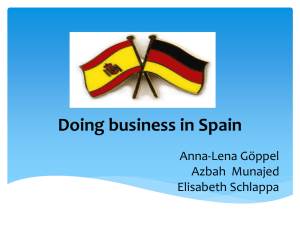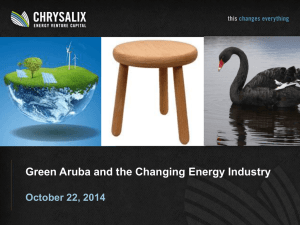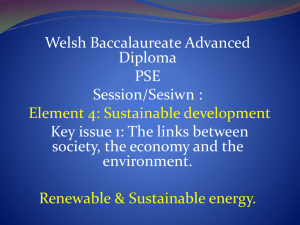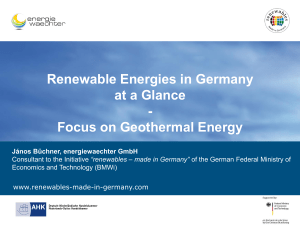EU Climate and Energy policy
advertisement
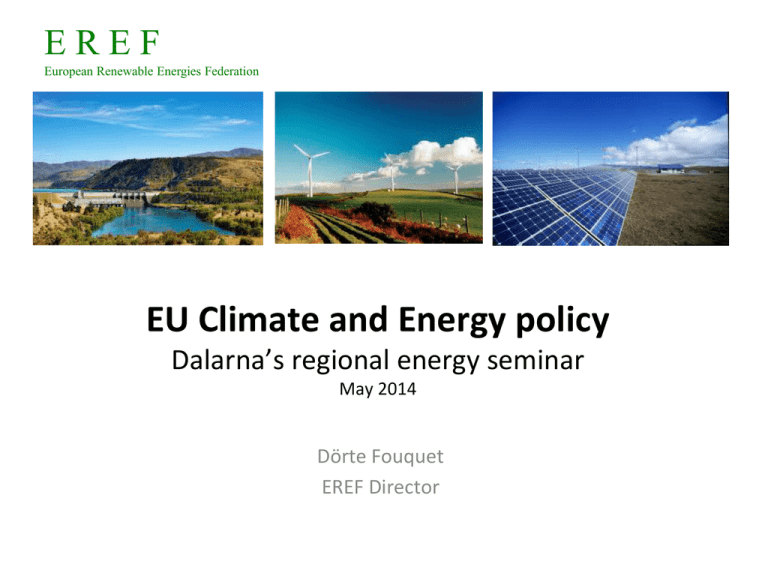
EREF European Renewable Energies Federation EU Climate and Energy policy Dalarna’s regional energy seminar May 2014 Dörte Fouquet EREF Director EREF European Renewable Energies Federation Transport policy: Clean Power for Transport package 2 EREF Clean Power for Transport package European Renewable Energies Federation Clean Power for Transport: A European alternative fuels strategy In January 2013, the Commission adopted a Clean Power for Transport package. Aims to facilitate the development of a single market for alternative fuels for transport in Europe Includes: • A Communication on a comprehensive European alternative fuel strategy: for the long-term substitution of oil as energy source in all modes of transport. • A Directive’s proposal on the deployment of alternative fuels infrastructure • An accompanying Impact Assessment and a Staff Working Document 3 Clean Power for Transport package EREF European Renewable Energies Federation The European context Oil dependence major issue for economy - but transport first Oil supplies 94% of energy to transport; 84% imported Cost for oil high and rising; price hikes hit economy Oil is cause for high CO2 and pollutant emissions from transport Comprehensive long-term European fuel strategy Aims to substitute oil for all transport modes Fuel mix: LPG, biofuels, natural gas, electricity, hydrogen European action required to ensure integrity of internal market Alternative fuel infrastructure EU-wide coverage important for citizens and industry Public intervention required through action on EU level 4 EREF European Renewable Energies Federation Directive on the deployment of alternative fuels infrastructure 5 Directive proposal on the deployment of alternative fuels infrastructure European Renewable Energies Federation EREF What is in the Commission’s proposal? Member States should adopt national policy frameworks for the market development of alternative fuels and their infrastructure, It sets binding targets for the build-up of alternative fuel infrastructure, including common technical specifications It defines the way of fuel labelling at refuelling points and on vehicles to ensure clarity in the consumer information on vehicle/fuel compatibility. Minimum infrastructure shall be provided, differentiated according to needs and technological maturity, for electricity, hydrogen, and natural gas CNG and LNG. 6 Directive proposal on the deployment of alternative fuels infrastructure European Renewable Energies Federation EREF European Parliament and Council reached an agreement on the text on April 2014 They amended the Commission proposal as follows: Each Member State should adopt a national policy framework with: • assessment of current and future development of the market of alternative fuels • national targets and objectives • measures to ensure that the national targets and the objectives are reached • measures promoting alternative fuels infrastructure in public transport • designation of the urban/suburban agglomerations which will be equipped with CNG refuelling points. Electricity supply for transport: an appropriate number of recharging points accessible to the public must put in place by 31 December 2020 (based on number of electric vehicles estimated to be registered in 2020) 7 EREF European Renewable Energies Federation The discussion on energy taxation Commission Proposal from 2011 Commission submitted a proposal in 2011 Core features: CO2 Element - single minimum rate for CO2 emissions (20 €/t CO2) for all sectors not covered by the EU ETS = introduction of a carbon price e.g. for households, transport, smaller businesses and agriculture AND: Renewable energy sources would not be subject to this CO2 element! Energy Content Element - minimum tax rates for energy based on the energy content of a fuel (€/GJ) rather than the volume = a fuel will be taxed on the basis of the amount of energy that it generates, and greater energy efficiency will automatically be rewarded THUS: One GJ would be taxed in the same way, regardless of the product producing it. 8 EREF European Renewable Energies Federation The discussion on energy taxation Commission Proposal from 2011 But… - … already in Parliament no support: - Luxembourgian MEP and Rapporteur Astrid Lulling (EPP), and Swedish MEP and shadow Rapporteur, Olle Ludvigson (S&D): - system based on energy content and on CO2 would automatically redistribute the relative advantages of various fuels in terms of CO2 emissions - no CO2 tax on biomethane and a lower CO2 tax on NG - BUT: too early! - Up to 50% tax reduction on the energy content (9,6€/GJ for all fuels) should be granted until 2030 And… - Taxation requires unanimity vote in the Council - Member States do not like the Commission’s proposal 9 EREF European Renewable Energies Federation The EU 2030 climate and energy framework 10 EREF European Renewable Energies Federation 2030 Climate and Energy Package European Commission White Paper on 2030 framework Published on 22 January 2014 Binding target of 40% GhG reduction by 2030 with national binding targets. EU-wide binding target of 27% for RES by 2030 Without national binding targets. Binding on the EU only, not on Member States. Revision of the RESD for the period after 2020. New European Governance National plans on plans to achieve 203 reductions, amount of RES, new nuclear capacities, CCS infrastructure plans. Commission assessment of the plans Still a lot of unclarity … End of subsidies for mature technologies in 2020-2030 timeframe EREF 2030 Climate and Energy Package European Renewable Energies Federation Member States European Council conclusion (20-21 March): Head of States and Governments to take a clear decision by October 2014 No agreement on the targets and ambition level Call for a supporting framework for advancing RES Next European Council (27 June 2014): The framework will be discussed at the next Council Discussion focused on CO2 emissions and effort sharing EREF 2030 Climate and Energy Package European Renewable Energies Federation European Parliament Parliament in favor of three mutually reinforcing binding targets for 2030 Ambition level of at least 30% for RES (40% CO2 and 40%EE) However, very slim majority New Parliament to come with expected a lot of Eurosceptic: Hard to assess the impact of the elections on Parliament position EREF 2030 Climate and Energy Package European Renewable Energies Federation Next steps: High possibility of a two step approach: - Agreement on the climate target: pressure from international level - stronger consensus than on RES, - Ban Ki Moon meeting in September - already discussions on effort sharing - Discussion on the RES and Energy Efficiency: review of the energy efficiency directive this summer - Commission currently analysis which article of the RES Directive do not expire by 2020 - Considering a new RES Directive but not confirmed - Work on how the new Governance will look like: but will certainly not be binding 14 EREF 2030 Climate and Energy Package European Renewable Energies Federation Discussion on Energy Efficiency: - So far there is nothing in the White paper related to it - Review of the energy efficiency directive was expected this summer - However likely to be delayed to Autumn - Commission will use the outcome of a public consultation to prepare the review 15 EREF 2030 Climate and Energy Package European Renewable Energies Federation Additional Commission work: Report on Energy dependency March European Council ask the Commission for a 25 years plan on EU energy dependency (context of the crisis in Ukraine): Priority for the Commission Led directly by the Director General Mr Ristori Report to be presented at the European Council of June Study of energy subsidies Aim is to bring more transparency to subsidies given to the conventional energy sector Announced by Oettinger in November last year Prepared by a consortium of external consultants Interim report before the summer and final report in September Report to take a historical perspective 16 EREF European Renewable Energies Federation Attack on the Directive 2009/28/EC 17 EREF Attack on the Directive 2009/28/EC European Renewable Energies Federation Questions from Swedish Court to the ECJ: Are Article (2(k)) and Article 3(3) of Directive 2009/28/EC to be interpreted as meaning that they permit a Member State to apply a national support scheme as above, in which only producers situated in the territory of that country can participate and which has the result that those producers have an economic advantage over producers who cannot be issued with an electricity certificate? Can a system such as that described in question 1 — in the light of Article 34 (TFEU) — be regarded as constituting a quantitative restriction on imports or a measure having equivalent effect? If the answer to question 2 is affirmative, can such a system be compatible with Article 34 (TFEU) as regards the objective of promoting the production of electricity from renewable energy sources? How is the consideration of the above questions affected by the fact that the restriction of the support scheme to include only national producers is not expressly governed in national law? 18 EREF Attack on the Directive 2009/28/EC European Renewable Energies Federation Background: Ålands Vindkraft power plant on the Ålands islands - fed electricity into the Swedish grid - not connected to the Finnish grid - sought for financial support (certificates) from Sweden Swedish authorities refused - not located in Sweden - Swedish support scheme only for electricity Sweden can use to reach its mandatory national target under Directive 2009/28/EC? -… Sounds like a repetition from the past… - EFET had tried a similar thing in 2008… 19 EREF Attack on the Directive 2009/28/EC European Renewable Energies Federation Response by the Advocate General Yves Bot: Directive 2009/28/EC allows Member States “national support schemes” BUT: Swedish support scheme = “measure having equivalent effect” Prohibited under Art. 34 TFEU, unless justified. Justifications not possible: - electricity markets nowadays more liberalized - i.e. changed circumstances since ECJ PreussenElektra - Guarantees of origin allow tracking of renewable energy quality - no reliable proof that national support schemes would blast if also support to renewable energy projects elsewhere - environmental protection requires support of renewables everywhere rather than financing conventional energy within own territory Conclusion: Art. 3(3) Directive 2009/28/EC needs to be changed! 20 EREF Attack on the Directive 2009/28/EC European Renewable Energies Federation What now? European Parliament petitioned to be allowed to join proceedings Court has not ruled on this petition so far Court to deliver judgment normally some months after conclusions be the Advocate General Free whether or not to follow his line of argument About 75% of the cases, the ECJ follows BUT: significant delay as highly political??? Conclusions came in January 2014 In “topically related” case already in May 2013 (C-204/12 – C208/12 Essent) 21 EREF European Renewable Energies Federation Guidelines on environmental and energy State aid for 2014-2020 22 EREF European Renewable Energies Federation Guidelines on environmental and energy State aid for 2014-2020 Adopted by the Commission on 9 April 2014 Enter into force on 1 July 2014 The guidelines are soft law. However, actually “self-binding” the European Commission: when assessing a national renewable energy support scheme which is designed as State aid, Commission will (almost) have to approve it if it complies with the Guidelines. State aid not in accordance with the Guidelines may still be approved! 23 EREF European Renewable Energies Federation Guidelines on environmental and energy State aid for 2014-2020 Type of support: Type of support allowed based on installation size: - Installations under 500kW (3MW wind): Feed-in tariff still possible - Installations under 1MW (6MW wind): Feed-in premium - Installations above 1MW (6MW wind): Feed-in premium and technology neutral tendering Member State have several derogations where they can decide: not to use a bidding process And/or to use exclude certain technologies from the bidding process EREF European Renewable Energies Federation Guidelines on environmental and energy State aid for 2014-2020 Gradual implementation In 2015 and 2016: 5% of new RES electricity capacities should be granted by technology neutral tendering. In 2016, installations above 500kW (3MW wind) should receive a Feed-in premium From 2017, all installations above 1MW (6 MW for wind), should apply for support through a technology neutral bidding process and will receive a Feed-in premium EREF European Renewable Energies Federation Guidelines on environmental and energy State aid for 2014-2020 Analysis of the guidelines Overall, it is not positive for the RES industry Globally in favor of large-scale centralized project and mature technologies However, a lot of exemptions have been introduced that give more flexibility to member States Final version clearly improved from the 1st drafts However Still an excess of power by the European Commission Lack of reflection of the current EU energy system situation No proven record of use and success over a longer period of the methodologies used such as the introduction of a very restricted choice of state aid mechanisms EREF European Renewable Energies Federation Thank you for your attention!
